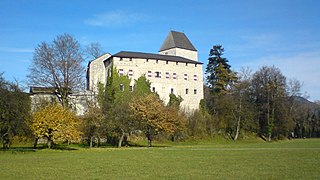
Brandenberg is a municipality in the Austrian state of Tyrol in the district Kufstein. It consists of the Brandenberg village and the Aschau locality.

Langkampfen is a municipality in the Austrian state of Tyrol between Kufstein and Wörgl. The name comes from the Latin Longus campus, which means the long field.

Walchsee is a municipality in the Austrian state of Tyrol in the Kufstein district. It is located in the lower Inn valley and belongs to the "Kaiserwinkl" and the "Untere Schranne".

Erl is a municipality of 1,400 inhabitants in the Kufstein district in western Austria. It lies 15 km north of the administrative town of Kufstein in the northern part of the Tyrol, at the border with Bavaria, Germany.

Thiersee is a large municipality in the Kufstein district in the Austrian state of Tyrol located 5 km west of Kufstein, below the northern border with Bavaria, Germany.

Kirchdorf in Tirol is a municipality in the Kitzbühel district in the Austrian state of Tyrol located 12.2 km (7.6 mi) north of Kitzbühel as well as 3 km (1.9 mi) north of Sankt Johann in Tirol at the Kitzbühler Ache. By area, Kirchdorf is the second largest municipality in the district. The village obtained its name from an old church which was built in the 8th century. The main sources of income are agriculture and tourism.

Bad Häring is a municipality in the Kufstein district in the Austrian state of Tyrol located 4.30 km northwest of Wörgl and 9 km south of Kufstein. A strong sulfur source was found in 1951 resulting in foundation of health tourism. In 1996 the location was named the "first air spa of Tyrol“.

Ebbs is a municipality in the Kufstein district of Tyrol in Austria. The village is located in the Judicial district of Kufstein and in 2016 had a population of 5,480.

Kirchbichl is a municipality in the Kufstein District in the Austrian state of Tyrol located 10 km south of Kufstein and 3 km northeast above Wörgl. It has six parts and its main source of income is cement industry.

Kramsach is a municipality in the Kufstein district in the Austrian state of Tyrol located 27 km southwest of Kufstein and 16.5 km west of Wörgl, at the northern side of the Inn River. Its main sources of income are the marble, timber and glass industries, as well as summer tourism. Kramsach is also known as the "Lake village of Tyrol" because there are six lakes nearby.

Mariastein is the smallest municipality in the Kufstein district in the Austrian state of Tyrol located 4 kilometers north of Wörgl and 11.5 kilometers southwest of Kufstein. Already a fifteenth century pilgrimage destination, it became more popular after a local statue of Mary, which had been removed to Bavaria in the late seventeenth century, was said to have returned to the church in Mariastein on its own.

Münster is a municipality in the Kufstein district in the Austrian state of Tyrol located 20 km west of Wörgl and 34 km southwest of Kufstein. It is the westernmost community of the district and lies at the northern side of the Inn River. The main sources of income are tourism, agriculture and a bottling factory for mineral water.

Niederndorf is a municipality in the Kufstein district in the Austrian state of Tyrol located 7 km north of Kufstein and 2 km north above Ebbs near the border to Bavaria, Germany. The main source of income is agriculture. The village was mentioned for the first time in documents in 1230.

Niederndorferberg is a municipality in the Kufstein district in the Austrian state of Tyrol located 8 km north of Kufstein and 3.4 km north above Ebbs near the border to Bavaria, Germany. It has six parts and was once connected with Niederndorf before it became an own community. The main source of income is the production of milk & cheese.

Radfeld is a municipality in the Kufstein district in the Austrian state of Tyrol located 1 km east of the town of Rattenberg, 13 km west of Wörgl, and 24 km southwest of Kufstein.

Reith im Alpbachtal is a municipality in the Kufstein district in the state of Tyrol located in the Alpbachtal valley, 32.9 km southwest of Kufstein, 19.6 km west of Wörgl, and 44.1 km east of Innsbruck, the main capital of Tyrol.

Rettenschöss is a municipality in the Kufstein district in the Austrian state of Tyrol located 10.20 km northeast of Kufstein and 6 km northeast of Ebbs below the northern border to Bavaria, Germany.

Scheffau am Wilden Kaiser is a municipality in the district Kufstein in the Austrian region of the Sölllandl. It is located 8.50 km southeast of Kufstein and 13 km northwest of Kitzbühel and has three subdivisions. The main source of income is summer tourism. The village has a public swimming area.

Schwoich is a municipality in the Kufstein district in the Austrian state of Tyrol located 5.50 km south of Kufstein at the southern side of the Inn River. The village has nine hamlets. Settlement of the area began in the 6th century but the community was mentioned for the first time as "Swiuch / Schweng" in 1280.

Bad Leonfelden is a municipality in the district of Urfahr-Umgebung in the Austrian state of Upper Austria. Steven Beller, author of A Concise History of Austria, who has family links to Bad Leonfelden, cites episodes from the town's history from its foundation in 1292 to the 21st century, to demonstrate the impact of historical and political events on the local life in Austria's rural provinces. The Jugendstil mosaicist Leopold Forstner was born there.























